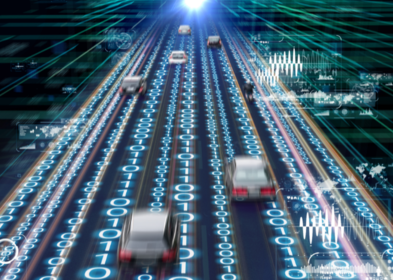
26/01/2023
Smart cities: technological applications for (increasingly) intelligent cities
Francesca Del Bello
ENEA's Robotics and Artificial Intelligence Laboratory, based in Italy, presents a set of sensors enabling real-time analysis of road surface conditions.
It all started with Rio: it was from the model experimented in the shadow of the Corcovado's peak that we began to speak about smart cities. It was back in 2010 (quite back in the past, given the ultra-fast pace of the ever-changing technologies) when the Brazilian megalopolis launched a project to adopt solutions that, through the implementation of advanced information and telecommunications technologies, intended to bring the local administration closer to citizens, contributing to making the city fairer, more inclusive and increasing its overall quality of life. A first, important experiment that opened a path in the making, and one with enormous potential for development.
But what is a smart city? Giving a single definition is far from easy, as the debate in recent years has produced a plurality of approaches - which, in fact, reflect the complexity of the topic. We'll use here the definition given by the European Commission in an article dated 13 July 2022: "[u]n intelligent city is a place that integrates physical, digital and human systems into traditional networks and services to make better use of energy resources and reduce emissions for the benefit of citizens and businesses." A definition that, as the Commission itself explains, goes beyond the technological and digital perimeter to integrate the design of more energy-efficient buildings, the use of renewable energy sources, the development of smarter urban transport networks, and even the enhancement of water supply and improved waste disposal systems. A systemic and integrated approach that puts citizens and their well-being at the centre. And, above all, a system that is much less science fiction than it sounds, as demonstrated by the cities that, in the wake of the Rio experience, are adopting a similar approach: ranging from the European experiences in London, Paris and Amsterdam, to the US examples of New York and Washington, and the Asian examples of Tokyo or Singapore.
Italy, for its part, is quite active under a research and development perspective. Although efficiency models comparable to the European and global metropolises mentioned above have not yet been implemented in our country, virtuous examples are also beginning to spread in the peninsula. Important R&D programmes are underway: these work on increasingly sophisticated technologies to be applied (also) on smart cities. An example of this is the activity of the Robotics and Artificial Intelligence Laboratory of ENEA, the Italian National Agency for New Technologies, Energy and Sustainable Economic Development.
As part of the Smart Road project, which in turn is part of the 'Electric System Research' programme financed by the Ministry of the Environment and Energy Security, the Laboratory has in fact developed latest-generation sensors dedicated to electric vehicles (both self-driving and human), capable of monitoring the city by detecting the state of the road surface. "The basic idea is that of autonomous driving vehicles that act as sensors to measure city conditions in a capillary manner and improve safety, traffic flows and driving comfort, with benefits also in terms of energy saving and sustainability," explains Sergio Taraglio, ENEA researcher in the Robotics and Artificial Intelligence Laboratory of the Energy Technologies and Renewable Sources Department, and head of the activity.
The analysis is carried out using two different sensors. The first, as Taraglio explains, exploits LiDAR (Light Detection and Ranging) technology based on a laser capable of precisely measuring the geometric distances of the road surface: this detects any deviation (represented, for example, by a pothole or a bump) which is then signalled on the display. The second sensor, on the other hand, uses a camera that, mounted on the front of the vehicle, analyses the acquired video stream using artificial intelligence and a deep neural network. The second sensor is thus able to detect all those objects that LiDAR technology would not allow to be captured, lattice cracks or defects in road markings, for example.
Once the information is acquired - which is geolocalised and collected in real time - it is sent to the smart city manager to map road conditions and allow repairs to be planned.
But that's not all: on the autonomous vehicles used for experimentation, the lab is also developing a system for analysing the sound context, with a twofold objective: 'on the one hand to measure noise pollution, and on the other to enable the autonomous vehicle to use the sound information to manage potentially dangerous situations: for example, in the event of an emergency vehicle approaching, the vehicle must be able to recognise the situation and clear the roadway as far as possible,' Taraglio comments.
A project, that of ENEA, which well represents the development potential of the many technologies revolving around smart cities. A potential which, however, to be fully exploited, requires a systemic and strategic approach to analysing the enormous amount of data collected - with all the grey areas that this approach still entails.
But what is a smart city? Giving a single definition is far from easy, as the debate in recent years has produced a plurality of approaches - which, in fact, reflect the complexity of the topic. We'll use here the definition given by the European Commission in an article dated 13 July 2022: "[u]n intelligent city is a place that integrates physical, digital and human systems into traditional networks and services to make better use of energy resources and reduce emissions for the benefit of citizens and businesses." A definition that, as the Commission itself explains, goes beyond the technological and digital perimeter to integrate the design of more energy-efficient buildings, the use of renewable energy sources, the development of smarter urban transport networks, and even the enhancement of water supply and improved waste disposal systems. A systemic and integrated approach that puts citizens and their well-being at the centre. And, above all, a system that is much less science fiction than it sounds, as demonstrated by the cities that, in the wake of the Rio experience, are adopting a similar approach: ranging from the European experiences in London, Paris and Amsterdam, to the US examples of New York and Washington, and the Asian examples of Tokyo or Singapore.
Italy, for its part, is quite active under a research and development perspective. Although efficiency models comparable to the European and global metropolises mentioned above have not yet been implemented in our country, virtuous examples are also beginning to spread in the peninsula. Important R&D programmes are underway: these work on increasingly sophisticated technologies to be applied (also) on smart cities. An example of this is the activity of the Robotics and Artificial Intelligence Laboratory of ENEA, the Italian National Agency for New Technologies, Energy and Sustainable Economic Development.
As part of the Smart Road project, which in turn is part of the 'Electric System Research' programme financed by the Ministry of the Environment and Energy Security, the Laboratory has in fact developed latest-generation sensors dedicated to electric vehicles (both self-driving and human), capable of monitoring the city by detecting the state of the road surface. "The basic idea is that of autonomous driving vehicles that act as sensors to measure city conditions in a capillary manner and improve safety, traffic flows and driving comfort, with benefits also in terms of energy saving and sustainability," explains Sergio Taraglio, ENEA researcher in the Robotics and Artificial Intelligence Laboratory of the Energy Technologies and Renewable Sources Department, and head of the activity.
The analysis is carried out using two different sensors. The first, as Taraglio explains, exploits LiDAR (Light Detection and Ranging) technology based on a laser capable of precisely measuring the geometric distances of the road surface: this detects any deviation (represented, for example, by a pothole or a bump) which is then signalled on the display. The second sensor, on the other hand, uses a camera that, mounted on the front of the vehicle, analyses the acquired video stream using artificial intelligence and a deep neural network. The second sensor is thus able to detect all those objects that LiDAR technology would not allow to be captured, lattice cracks or defects in road markings, for example.
Once the information is acquired - which is geolocalised and collected in real time - it is sent to the smart city manager to map road conditions and allow repairs to be planned.
But that's not all: on the autonomous vehicles used for experimentation, the lab is also developing a system for analysing the sound context, with a twofold objective: 'on the one hand to measure noise pollution, and on the other to enable the autonomous vehicle to use the sound information to manage potentially dangerous situations: for example, in the event of an emergency vehicle approaching, the vehicle must be able to recognise the situation and clear the roadway as far as possible,' Taraglio comments.
A project, that of ENEA, which well represents the development potential of the many technologies revolving around smart cities. A potential which, however, to be fully exploited, requires a systemic and strategic approach to analysing the enormous amount of data collected - with all the grey areas that this approach still entails.






